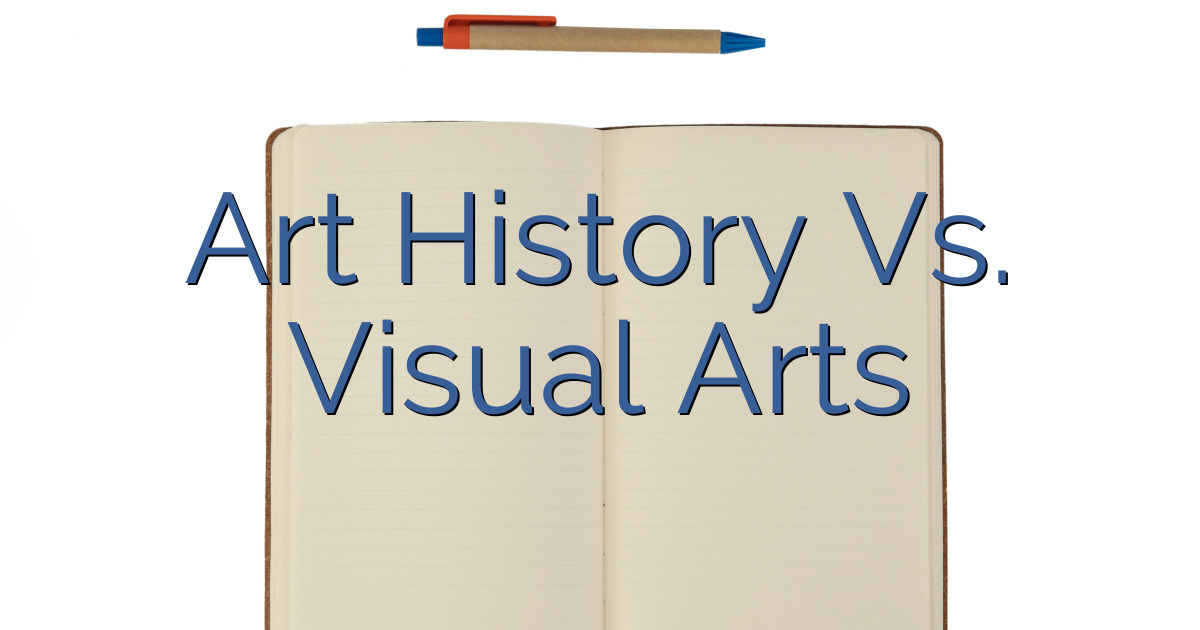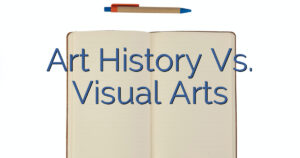
Did you know that art history and visual arts are two distinct majors that offer unique opportunities for creativity and career growth?
In this article, we will explore the differences and similarities between these two fields, shedding light on the curriculum, skills developed, career prospects, and more.
Whether you’re passionate about analyzing masterpieces or creating your own, understanding the nuances of these majors will help you make an informed decision that aligns with your interests and aspirations.
Let’s dive in!
Table of Contents
Key Takeaways
- Art History and Visual Arts are two distinct majors with different focuses and career paths.
- Art History involves researching the historical, cultural, and social context of artworks, while Visual Arts emphasizes the creation of art and the development of technical skills.
- Technology has had a profound impact on art analysis, with digital imaging techniques allowing for detailed examination of artworks.
- Art History curriculum focuses on the study of artworks, historical context, and critical analysis, while Visual Arts curriculum emphasizes the creation of art and the development of technical skills.
Overview of the two majors: Art History and Visual Arts
Art History and Visual Arts are two distinct majors with different focuses and career paths. In Art History, the importance of research cannot be overstated. As an art historian, you delve into the historical, cultural, and social context of artworks. Through meticulous research, you gain insights into the artists, their techniques, and the significance of their creations. This knowledge allows you to critically analyze and interpret artworks, contributing to the broader understanding and preservation of cultural heritage.
Technology has had a profound impact on art analysis in recent years. With the advent of digital imaging techniques, art historians can now examine artworks in unprecedented detail. High-resolution scans and digital restoration techniques help reveal hidden layers, colors, and textures, shedding light on the artist’s intentions and creative process. Additionally, technology has made it easier to access and share information, fostering collaboration and expanding the reach of art historical research.
Overview of the curriculum and requirements of the two majors
The curriculum and requirements for the two majors differ in terms of the courses and credits needed.
In Art History, the focus is on the study of artworks, their historical context, and critical analysis. The course offerings include classes like Renaissance Art, Modern Art, and Contemporary Art.
Visual Arts, on the other hand, emphasizes the creation of art and the development of technical skills. Students in this major can choose from a wide range of studio courses such as painting, sculpture, and photography.
Faculty expertise also varies between the two majors. Art History professors have specialized knowledge in specific time periods or art movements, while Visual Arts faculty members are practicing artists who bring their own artistic experience and techniques to the classroom.
Overall, the curriculum and requirements of these majors cater to different interests and career paths within the field of art.
Overview of coursework, assessments, and grading methods
When it comes to coursework, assessments, and grading methods, you’ll find a variety of assignments and evaluation techniques in both art history and visual arts majors. Here is an overview of the coursework assessments and grading methods commonly used in these disciplines:
- Research Papers: Both majors often require students to write research papers that analyze and interpret artworks or explore art historical topics. These papers are assessed based on the depth of research, critical analysis, and clarity of writing.
- Studio Projects: In visual arts, students are often tasked with creating their own artworks. These projects are evaluated based on creativity, technical skill, concept development, and execution.
- Exams: Both majors may have written exams that test students’ knowledge of art history, theory, and techniques. These exams typically assess understanding, analysis, and interpretation.
- Critiques: In visual arts, students participate in critiques where they present their work to peers and faculty for feedback. These critiques focus on the quality of the artwork, concept development, and the ability to articulate ideas.
Overall, coursework assessments and grading methods in both art history and visual arts aim to assess students’ understanding of the subject matter, critical thinking skills, and artistic abilities.
Comparison of Skills Developed: Creative Thinking
Students in both art history and visual arts majors develop their creative thinking skills through coursework assessments and grading methods.
In art history, students engage in creative problem solving by analyzing and interpreting artworks from different historical periods. They are required to critically evaluate the artistic techniques, symbols, and meanings behind the artwork, fostering their ability to think outside the box and generate unique perspectives.
On the other hand, visual arts majors develop their creative thinking skills through artistic interpretation. They are encouraged to experiment with various mediums and techniques, allowing them to explore different ways of expressing their ideas and emotions.
Through coursework assessments and grading methods, both majors cultivate their ability to think creatively and approach artistic challenges with innovative solutions. This enables them to become well-rounded artists with the capacity to push boundaries and create meaningful works of art.
Comparison of Career Opportunities and Job Roles: Art Education
If you’re considering a career in education, exploring opportunities in the field of art can open up a world of possibilities for you.
Art education as a career offers various teaching opportunities and allows you to make a positive impact on students’ lives.
As an art teacher, you can work in schools, colleges, or community centers, helping students develop their artistic skills and creativity.
Beyond traditional classrooms, art educators also have the chance to engage in community outreach initiatives. This involves organizing art workshops, exhibitions, and events that promote artistic expression and bring art to underserved communities.
By combining your passion for art with teaching, you can inspire and empower others while fostering a love for creativity.
Art education truly provides a fulfilling and meaningful career path for those who are passionate about both art and education.
Comparison of Salary Potential: Job Market Trends
The salary potential for teachers in the field of art education varies based on location and level of experience. When comparing the salary potential between art history and visual arts, several factors come into play.
Here are some key points to consider:
- Location: Salaries can vary significantly depending on the location. Urban areas and regions with a high cost of living generally offer higher salaries compared to rural areas.
- Level of Experience: As with any profession, experience plays a significant role in determining salary. Teachers with more years of experience and a strong track record may command higher salaries.
- Education and Credentials: Advanced degrees and specialized certifications can also positively impact salary potential. Those who have pursued further education and obtained additional qualifications may earn higher salaries.
- Job Market Trends: The demand for art history and visual arts teachers may vary over time. It is essential to stay informed about the job market trends to understand the potential salary range.
Overall, the salary potential in both art history and visual arts education can be influenced by various factors, and it is crucial for individuals to consider their location, experience, education, and the current job market trends when assessing their earning potential.
Similarities between Art History and Visual Arts curricula
In comparing the curricula of Art History and Visual Arts, you will find both similarities and differences.
One similarity is that both disciplines require a strong foundation in art theory and history. Understanding the historical context and the evolution of art is crucial in both fields. Additionally, both disciplines emphasize the importance of critical thinking and analysis when studying and interpreting artworks.
However, there are also significant differences between the two. Art History focuses more on the study of art through research, analysis, and writing, whereas Visual Arts places a greater emphasis on the creation and production of art. Visual Arts students engage in hands-on studio work, honing their skills in various mediums and techniques.
While they share some common ground, Art History and Visual Arts offer distinct approaches to the study and practice of art.
Difference in job prospects between the two majors
While job prospects for Art History majors may include careers in museums or galleries, Visual Arts majors may have more options in fields such as graphic design or illustration. The job market for Art History majors tends to be more specialized, with opportunities primarily focused in the art world. On the other hand, Visual Arts majors have a wider range of career paths available to them due to their practical skills and versatility.
Some key differences in job prospects between the two majors include:
- Art History majors:
- Curatorial positions in museums or galleries
- Art research and writing for publications
- Art education and teaching
- Visual Arts majors:
- Graphic design for advertising agencies or design firms
- Illustration for publishing companies or freelance work
- Animation or multimedia design for film and television
Overall, while both majors offer unique career paths, Visual Arts majors may have a broader range of opportunities in various industries beyond the traditional art world.
Factors to consider when choosing between the two majors: interests
When deciding between the two majors, consider your personal interests and what you enjoy creating the most.
Choosing between Art History and Visual Arts majors requires careful consideration of your personal preferences and career goals.
Art History focuses on the study of art throughout history, analyzing its cultural, social, and political contexts. If you have a passion for research, critical analysis, and a deep appreciation for the artistic achievements of different cultures and time periods, Art History may be the right choice for you.
On the other hand, Visual Arts majors concentrate on the creation of visual art forms, such as painting, sculpture, and photography. If you have a strong desire to express your creativity and explore various artistic mediums, Visual Arts might be the better fit.
Ultimately, your decision should align with your interests and aspirations, as both majors offer unique opportunities for personal and professional growth.
Conclusion
So, you’ve reached the end of this enlightening journey comparing the two majestic majors of Art History and Visual Arts.
It’s been quite a ride, hasn’t it? Delving into the depths of creative thinking, exploring the captivating world of art education, and even taking a peek at the enticing realm of salary potential.
Now, armed with all this knowledge, you can make an informed decision that will shape your future.
Remember, dear reader, the choice between these two paths is as delicate as a brushstroke on a canvas. Choose wisely, and may the art gods forever bless your creative endeavors.

